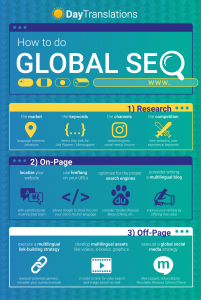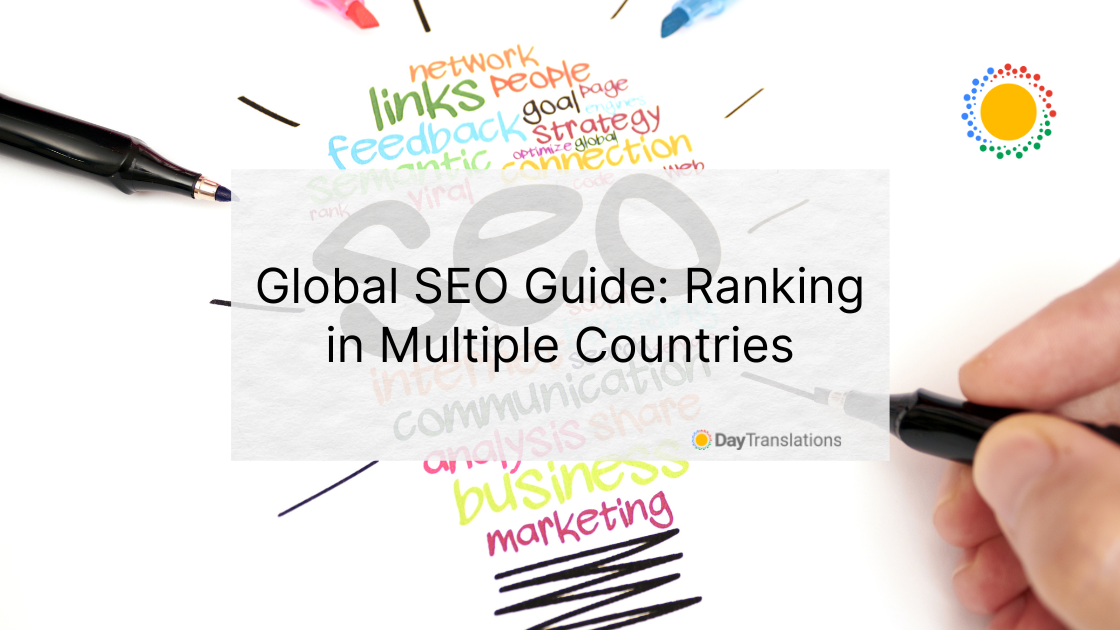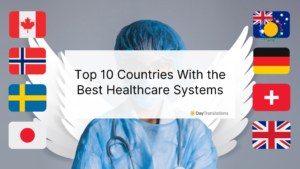In starting your business globalization plan, it is essential to think of all the details that go with your brand and marketing strategies, which include among other things, preparing your website for global SEO.
You must be prepared for the influx of multiethnic site visitors. Expect to receive inquiries from consumers who do not speak your language. If you sell your products online, you should be prepared to accept orders from other countries. These are indications that international consumers are getting interested about your products.
If this is happening to you right now, it’s time to prepare a plan for a strategic international SEO scheme.
The Purpose of Going Global
Corporations enter the international market scene for a key purpose – business growth and expansion. Targeting promising markets that speak the same language is easier, because the company does not have to change their content that much.
The business expansion plan becomes more complicated when the company wishes to explore markets where customers speak different languages. This means that websites, content, marketing strategies and more must be carefully planned, to ensure that they will be able to reach their target audiences at the right time and speak to them in their own tongue.
A company website is the frontliner in international market penetration. Thus, it should be prepared for the global audience. This global SEO guide will be of great help in ensuring that you do it right the first time.
Preparing Your Website
You want your website to have as many visitors as possible and convert those visitors into consumers, which equates to business growth and revenues. Your success in international expansion depends on your resources, type of business and the number of customers you generate. It takes strategic planning to achieve that. This global SEO guide will help you prepare your site for your global audiences, guaranteeing that your potential customers will be able to access content based on their web query. This is about the technical aspects involved in making sure that your site is ready for your global expansion.

Understanding the Terminology
In order for you to understand the complexities of global SEO, you have to learn some technical terminology that you will come across this global SEO guide. While you are not likely to be designing your website and would be hiring a professional to do it, understanding the terminology will help you to comprehend the discussions during planning meetings and follow the flow of conversation.
1. Country-specific top level domain (ccTLD). This is assigned by the Internet Corporation for Assigned Names and Numbers (ICANN), a nonprofit organization based in Los Angeles. It coordinates the procedures and maintenance of various databases connected with the numerical spaces and namespaces of the Internet, which ensures the secure and stable operation of the network. The Google Search Console automatically geo-targets the ccTLD.
2. Generic top-level domain (gTLD). This is not country-specific, and you are more familiar with this. The domain names help to identify the IP addresses. For example, mybrand.com can have several IP addresses. Domain names are found in the site URLs to distinguish specific web pages. If your website URL is http://www.mybrand.com/index.html, your domain name is mybrand.com. Each domain name has a suffix that tells you in which top level domain it is connected, for example, .gov, .net, .org or .com.
3. Subdomain. This is a key part of the domain, represented by characters that appear before the name of the root domain. The most common is www. Subdomains are utilized for branded micro sites, region targeting or marketing.
4. Subfolder. This is part of the subdomain or domain. It’s a section that is identified by a trailing slash, for example, www.mybrand.com/sp.
5. Parameter. It qualifies the site URL. It can change the page content according to the URL’s parameters or track a site user’s path to the right content. The parameter is often used to define the language the web page uses. An example would be www.mybrand.com/page1?lang=es for Spanish language.
6. Country. This refers to the country with an ISO code or a ccTLD one provided by ICANN. Google applies the ISO 3166-1 Alpha-2 for hreflang such as CA for Canada, CN for China, US for the United States of America and GB for the United Kingdom of Great Britain and Northern Ireland.
7. Region. This refers to a group of countries according to geography, such as the Middle East and the European Union. Because they are not countries but a group of individual countries, geo-targeting is not yet available for them.
8. Hreflang. This is called an attribute or tag that tells a search engine like Google what language a specific web page uses. It helps the search engine show the results to a person using that particular language when searching. The tags show all the translated editions of a specific page and may have regional dialects as well.
9. Meta-language. It’s a tag employed by the search engine Bing to distinguish languages. Meta language tells Bing what language a current page uses.
10. Geo-targeting. Google Search Console and Bing Webmaster Tools permit owners of websites to call a particular domain, subdomain or subfolder and tells the search engine that the section or domain’s content is created specifically to target a specific country’s residents.
11. Translation. As the term implies, translation changes the original content into other languages. Translation should be done by native-speaking professional translators only.
________________________________________________________
Hey! Did you know we have a full Global Marketing guide – this piece will not only guide your marketing from a strategic, global perspective, but it will also introduce you to concepts such as global SEM, global Social Media, global Email marketing, and much more!
________________________________________________________
Defining Global SEO
It you notice that you are getting more inquiries from consumers from other countries, this means that foreign consumers were able to find your website, even if it is not in their own language. Now think how much more visitors your site would gain when you make it available in other languages. And converting those visitors into consumers means additional revenues for you.

So, are you ready to go local?
Various analyses done by different search engines, researchers, professional SEO service providers and tech experts have proven that searches for local content is a prevalent trend today. People around the world want to find information and products that are near them.
When you’re ready, here’s what you should do to implement an effective global SEO.
First, let’s define global SEO. Simply put, it optimizes web content for the various regions of the world. You have to provide content that could be adapted into different languages and cultures worldwide. It also means optimizing your site’s content to ensure that it will rank higher in the results page of the search engines that are popular in each locale. You have to understand that search results differ according to the location.
For example, you’re from Australia and you sell grapes. You want to target importers from Germany, Netherlands, China and Canada; therefore, your global SEO should optimize your content and your keyword: grapes in their specific language. For Canada, it could be ”grapes” for the English-speaking regions but ”grain de raisin” in the French-speaking regions. For China, you should optimize for 葡萄 (pútáo). For the Netherlands, you’ll be optimizing for ”druif” while for Germany, optimize for ”Traube.”
General SEO, Local SEO, and Global SEO
Whether you are optimizing for the local or global market, you need to apply general SEO practices, which comprise all the essential components that assist different search engines to crawl, index and include your site’s content in the search results.
1. General SEO
The key elements of general SEO are the speed of the site, backlinks, sitemap, optimized keyword/s, schema markup and UX (user experience).
2. Local SEO
On the other hand, local SEO is more for businesses with physical outlets in a country, state or city that maintain a website. Search engines rely on networks for business information, local directories and customer reviews to base the website ranking for local searches.
3. Global SEO
To target audiences around the world, you use global SEO. The practice requires more, since you are going to optimize for varied cultures, languages, consumer behaviors, local policies and Internet regulations in your marketing techniques and messages.
Privacy and Data Policies
These are primary considerations when doing global SEO. Many locations in Africa, Asia and Europe are now adopting privacy regulations to allow consumers to have control over the information they share online.

For global SEO, you have to review the Asia Pacific Data Regulation and Cyber Security Guide (Asia and Pacific region), Personal Data Protection Guidelines for Africa and the General Data Protection Regulation for Europe. The key here is to always be ready since data protection measures will surely be a factor in search engine rankings. Make sure that your pages for Terms and Conditions or Terms of Service, Privacy Policy and Cookie Policy are prepared and reflect the current inclusions.
Consider the Perspective of Google
While there are several search engines, including those that are exclusive to some countries such as South Korea’s Naver and China’s Baidu, Google is by far the most dominant across the world. Thus, for most website developers and owner, the priority is to optimize for Google.
Relevance
One of the most important factors Google considers is relevance. Google measures relevance through visitor behavior, off-page SEO and on-page SEO. The search engine’s various algorithms, particularly RankBrain works prominently to measure page rankings by determining user satisfaction and relevance of content.
This means that your content should be pertinent to your target audience. While you may have the original content in your own language, such as English, it is vital to satisfy the unique requirements of each individual market. Content for the American market would not be that relevant to Chinese consumers for example.
Build Trust
In your own country, you might be a popular brand that enjoys consumer loyalty. But when you enter foreign markets where you are virtually unknown, you have to start from the ground up. You have to create brand awareness and build consumer trust. Reach out to get reviews from the consumers in the new market who are already familiar with your brand.
Consistent Information
This factor particularly concerns your business name, phone number and address. The information should be consistent, as it matters to the search engines.
Consider local SEO
Cater to the unique behaviors and needs of each new market. Ensure that your brand matches the changes in each market. You have to develop an appeal that resonates well with each target location, since this is one of the most effective ways for consumers to find you. In so doing, you are showing Google that you care for your target audiences. Reach out to local influencers to get good reviews and recommendations. Develop creative ways so local media can feature your company and brand. Do not forget that local directory listings matter as well.

Global SEO Tactics
You’ve achieved success in your main market. Now you are ready for global expansion. And one of the primary things you should do is to know everything that you need to know about each market to ascertain your brand’s potential.
1. Research all target countries
We’ve mentioned that individual markets have unique needs. The industry where you belong likewise has its own strengths and weaknesses and some markets are ready for particular services and products compared to others. You have to identify the countries that will give you the best opportunities for growth and expansion.
Some of the data you should get from reports from competition and your own site traffic include the following:
· Countries where the bulk of visitors come from.
· Countries where most of the visitors become customers.
· Countries that show huge interest on your products but cannot get them yet.
· Markets your competitors are planning to enter. However, you should know the real reasons why they are pursuing these markets, so you can plan accordingly.
Aside from these factors, you can likewise assess your expansion opportunities through the following:
· Analysis reports for global trends in your specific industry
· Advanced models for business expansion
· Reports from international service markets and products
In short, you are gathering intelligence information in order to formulate informed decisions, using all the data and analyses you have to determine which specific cities or countries you’d be most profitable.
Another thing you have to consider is the SWOT (strengths, weaknesses, opportunities and threats) analysis on these markets on the industry-level.
Aside from the technical aspects, you should also include strategies that cater to the cultural aspects, such as recognizing local belief and traditions, including the opportunities to adapt your site to seasonal or traditional observances, such as international and local holidays and festivities and buying cycles by the local community.
2. Set your goals for global SEO
Based on the results of your research you’ll be able to set different goals since you already know the challenges and opportunities. Here’s what to do.
· Set the goals for your company
· Formulate your goals for marketing your brand
· Get your goals for global SEO from the marketing goals you’ve set
· Decide what metrics to use to track site performance based on your goals for search engine optimization
3. Analyze your opportunities
Which avenues will help you realize your goals?
Start with doing keyword research. You can use Bing Keyword Tool, Yandex Keyword Tool and Google Keyword Planner to find the significant keywords within your specific industry. Use them as references and combine them with other search results. See to it that your keyword research is language- and country-specific so you’ll get accurate data for each market.
Use other free tools like SuggestMrx to find keywords from Amazon, YouTube, Google and others. Moz Keyword Explorer helps determine how competitive your keywords would be. Monitor Backlinks is another free tool that can tell you how each search term will rank in Google. These tools have search filters for language and country.
4. Research behavior of target consumers
Explore the best opportunities to reach your target consumers by researching consumer behaviors. You can find out which forums they participate in, the blogs they read, the
sites they frequently visit, and the social media platforms they use and how much time they spend on each and the influencers they follow.
5. Analyze your competition
Analyzing your competitors provides you information about the challenges you are going to face and shows you the opportunities that your competitors discovered. Look for their activities through market and industry reports, their websites, backlinks and search traffic in order to understand the weaknesses and strengths of your various competitors.
6. Create a strong global SEO strategy
Use all the information and statistics you have gathered to formulate a strong strategy for your global SEO. First thing to do is hire a native-speaking translator to help transform your background materials into local context to ensure accuracy in the details. Next is to get your website prepared for global SEO, which requires localization services.
Your website developer should be implementing hreflang attributes in your URLs. Hreflang enables targeting particular countries by the main language spoken. However, you may have to resort to language targeting in order for your site to reach all the markets that speak the same language.
Another tactic you can use is location targeting particularly if you are engaged in e-commerce. Moreover, location targeting is effective in serving the needs of your target audience.
Your site could have gTLD or ccTLD domains, sub-directories and/or sub-domains. Sub-directories are effective if you are using the success of your current site as your advantage, while you use gTLD or ccTLD domains if you are building each website from scratch. On the other hand, using sub-domains is less complex than using sub-directories. Sub-domains are typically stand-alone pages where you can show specific content to target particular consumer groups by location or language.
It is better to optimize your site for other search engines aside from Google. Many international markets prefer to use other search engines. To ensure that your global SEO is complete, see to it that it is optimized for Bing (US and several markets), Yahoo! (Japan and Taiwan), Naver (South Korea), Yandex (Russia) and Baidu (China). There are others, such as Qihoo360 by So.com (China), Ask.com and DuckDuckGo.
International linkbuilding is critical for your global SEO strategy. It’s a very important factor when it comes to search engine ranking. Google recognizes it as consumer engagement. Having a number of backlinks particularly from authoritative references improves your authoritative standing as well.
You should work hard to have backlinks from websites of national brands, research institutions, universities and government. These important backlinks show the search engines that your content is relevant and credible. The ranking of your site will improve through mentions from local influencers and links from social media platforms, too.
Translators who are SEO specialists can help you garner links from local resources and sites such as social media, event listings, government and educational institutions, review sites, blogs, business directories and online forums and communities.
We hope that this global SEO guide will help you formulate your own global SEO strategies suitable to your specific international target locations.
Seize All the Opportunities for Global Success Allow Day Translations, Inc. to help you with your global SEO. We offer you a team of SEO experts who complement their technical expertise with the linguistic expertise. They can fully localize your website for multilingual audiences, so you can reach them in the language they prefer. Call us today at 1-800-969-6853 or send us an email at contact@daytranslations.com so we can fully discuss what you need. We’re available 24/7, every day of the year, which makes it convenient for clients who are in different time zones














Sorry, the comment form is closed at this time.